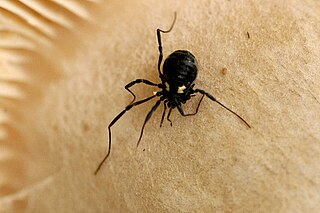
Caenorhabditis elegans is a free-living transparent nematode about 1 mm in length that lives in temperate soil environments. It is the type species of its genus. The name is a blend of the Greek caeno- (recent), rhabditis (rod-like) and Latin elegans (elegant). In 1900, Maupas initially named it Rhabditides elegans. Osche placed it in the subgenus Caenorhabditis in 1952, and in 1955, Dougherty raised Caenorhabditis to the status of genus.

The crimson rosella is a parrot native to eastern and south eastern Australia which has been introduced to New Zealand and Norfolk Island. It is commonly found in, but not restricted to, mountain forests and gardens. The species as it now stands has subsumed two former separate species, the yellow rosella and the Adelaide rosella. Molecular studies show one of the three red-coloured races, P. e. nigrescens, is genetically more distinct.

Rosellas are in a genus that consists of six species and nineteen subspecies. These colourful parrots from Australia are in the genus Platycercus. Platycercus means "broad-tailed" or "flat-tailed", reflecting a feature common to the rosellas and other members of the broad-tailed parrot tribe. Their diet is mainly seeds and fruit.

Cyclanthaceae is a family of flowering plants.

The elegant water shrew is a species of mammal in the subfamily Soricinae of the family Soricidae. It is the only species within the genus Nectogale. It lives in Sikkim and China.

The Nemastomatidae are a family of harvestmen with about 170 described species in 16 recent genera. Several fossil species and genera are known.

Carludovica is a genus in the family Cyclanthaceae. It is native to tropical America, from southern Mexico and Guatemala to Ecuador and Bolivia. Carludovica is named in honor of Charles IV of Spain and his wife Maria Luisa of Parma.

Fasciculation and elongation protein zeta-1 is a protein that in humans is encoded by the FEZ1 gene.

USS Content (SP-538) was a motorboat that served in the United States Navy as a patrol vessel from 1917 to 1919.

Littorinoidea are a superfamily of both sea snails and land snails which have a gill and an operculum, terrestrial and marine gastropod mollusks in the clade Littorinimorpha.

Carludovica palmata is a palm-like monocot plant. It is not a true palm. Its leaves are different from the leaves of true palms, and unlike true palms it does not develop a woody trunk. Its female flowers have large stigmas, and its male flowers have a lot of pollen.
Chaetonotus elegans is a species of gastrotrichs in the genus Chaetonotus. It is found in freshwater of Europe.

Crossocheilus, also known as the fringe barbs, flying foxes, or "algae eaters", is a genus of fish in the family Cyprinidae. It is distributed in China, India, Indonesia, Malaysia and Thailand in Asia. These fish occur in several types of habitat, often fast-flowing rivers with rocky bottoms.

Caenorhabditis elegans- microbe interactions are defined as any interaction that encompasses the association with microbes that temporarily or permanently live in or on the nematode C. elegans. The microbes can engage in a commensal, mutualistic or pathogenic interaction with the host. These include bacterial, viral, unicellular eukaryotic, and fungal interactions. In nature C. elegans harbours a diverse set of microbes. In contrast, C. elegans strains that are cultivated in laboratories for research purposes have lost the natural associated microbial communities and are commonly maintained on a single bacterial strain, Escherichia coli OP50. However, E. coli OP50 does not allow for reverse genetic screens because RNAi libraries have only been generated in strain HT115. This limits the ability to study bacterial effects on host phenotypes. The host microbe interactions of C. elegans are closely studied because of their orthologs in humans. Therefore, the better we understand the host interactions of C. elegans the better we can understand the host interactions within the human body.
Askellia elegans, the elegant hawksbeard, is a species of North American plants in the tribe Cichorieae within the family Asteraceae. It is native to central and western Canada and the northwestern United States.
Cucujomyces elegans is a species of fungi in the family Laboulbeniaceae. It is found in Argentina.
Cyclea elegans is a species of flowering plants in the family Menispermaceae. It is found in Sumatra, Malaya, Borneo. An isotype is kept at Kew Gardens Herbarium. It was collected on Mount Kinabalu Dallas.

Bauruemys is an extinct genus of turtles in the family Podocnemididae.
Allium elegans is a species of flowering plants. It is native to Tadzhikistan, Uzbekistan and Kirgizistan.

Saurauia elegans is a species of plant in the family Actinidiaceae. It is native to The Philippines. In The Philippines it is commonly called uyok and is used as a traditional medicine for lung ailments and also to decorate food dishes.












